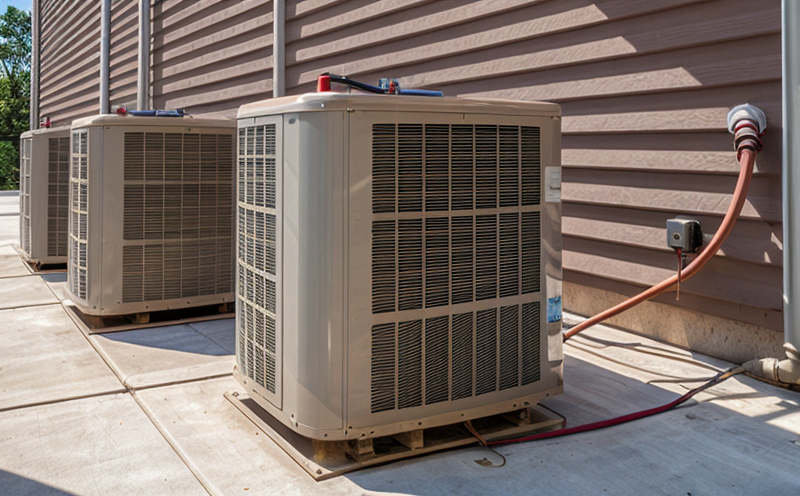EN 308-1 Heat Exchanger Testing
The European Standard EN 308-1 provides a comprehensive framework for testing heat exchangers in HVAC systems. This service is vital for ensuring the safety, efficiency, and compliance of heat exchangers used in various applications within the building infrastructure sector.
Heat exchangers are critical components in HVAC systems that transfer heat between two media without allowing them to mix directly. Testing these components ensures they operate efficiently, safely, and meet regulatory standards. The EN 308-1 testing protocol covers a range of tests, including pressure testing, leakage detection, thermal performance evaluation, and material integrity checks.
The process begins with thorough preparation of the heat exchanger specimen. This involves cleaning the unit to remove any dirt or debris that could interfere with the test results. The next step is to apply a specified pressure to the heat exchanger to check for leaks. If leaks are detected, they must be repaired before further testing can proceed.
Thermal performance evaluation is another crucial part of this service. This involves measuring how effectively the heat exchanger transfers heat between the two media. The test setup typically includes a controlled environment where the heat exchanger’s performance can be measured under specific conditions. Compliance with EN 308-1 ensures that these tests are conducted in an accurate and repeatable manner.
The material integrity check is performed to ensure the heat exchanger's materials meet the required standards for durability and safety. This includes checking the metal components for any signs of corrosion or degradation, as well as testing the bonding between different materials used in the construction of the unit.
Once all tests are completed, a detailed report is generated that outlines the results of each test. This report serves as a comprehensive document that can be used by quality managers and compliance officers to ensure that the heat exchanger meets all relevant standards and specifications.
The importance of this service cannot be overstated in today's world where sustainability and energy efficiency are top priorities. By ensuring that heat exchangers meet the strictest safety and performance criteria, we contribute to a more sustainable future.
Why It Matters
The integrity of HVAC systems is paramount for maintaining a safe and comfortable environment in buildings. Heat exchangers play a crucial role in the efficiency and safety of these systems, making their testing essential. Ensuring that heat exchangers meet the stringent requirements outlined in EN 308-1 not only guarantees compliance with international standards but also enhances operational reliability and extends the lifespan of HVAC equipment.
Compliance with this standard is crucial for quality managers and procurement officers who need to ensure their suppliers provide reliable, high-quality products. R&D engineers also benefit from this service as it helps them improve designs and materials used in heat exchangers. By adhering to EN 308-1, companies can demonstrate their commitment to safety and sustainability, thereby gaining a competitive edge in the market.
The standards set by EN 308-1 are not merely regulatory; they represent best practices that ensure the longevity of HVAC systems. This contributes significantly to reducing energy consumption and operational costs, which is particularly important for large buildings or facilities with high energy demands.
Furthermore, the testing protocol outlined in this standard helps identify potential issues early on, preventing costly repairs or replacements later down the line. This proactive approach ensures that buildings remain safe and efficient, contributing positively to both the environment and the economy.
Industry Applications
| Application | Description | |
|---|---|---|
| Data Centers | Ensuring efficient cooling of servers and other IT equipment. | |
| Commercial Buildings | Maintaining optimal indoor climate control for occupants' comfort. | |
| Residential Properties | Providing reliable heating and cooling solutions for homeowners. | |
| Manufacturing Facilities | Supporting the production processes by maintaining consistent temperatures. | |
| Hospitals | Educational institutions | Protecting sensitive equipment and ensuring a safe environment. |
| Application | Description |
|---|---|
| Military Installations | Supporting critical operations by maintaining stable environmental conditions. |
| Airports | Providing efficient climate control for passengers and staff. |
| Stadiums | Ensuring comfort during events and matches. |
| Laboratories | Maintaining precise temperature controls to ensure accurate research and testing. |
| Homes | Offering energy-efficient heating and cooling solutions for residents. |
Environmental and Sustainability Contributions
The testing of heat exchangers according to EN 308-1 contributes significantly to environmental sustainability. By ensuring that these components perform optimally, we can reduce energy consumption in buildings, leading to lower greenhouse gas emissions.
Efficient HVAC systems contribute to reducing the carbon footprint associated with heating and cooling operations. This is particularly important given the increasing emphasis on sustainable practices worldwide. Compliance with EN 308-1 helps facilities meet their environmental goals while enhancing operational efficiency.
The testing process also involves assessing the materials used in heat exchanger construction, ensuring they are durable and resistant to degradation over time. This reduces waste and extends the life cycle of HVAC equipment, further supporting sustainability efforts.
Moreover, by identifying potential issues early on through rigorous testing, we can prevent costly replacements or repairs, which would otherwise contribute to increased energy use and environmental impact.





